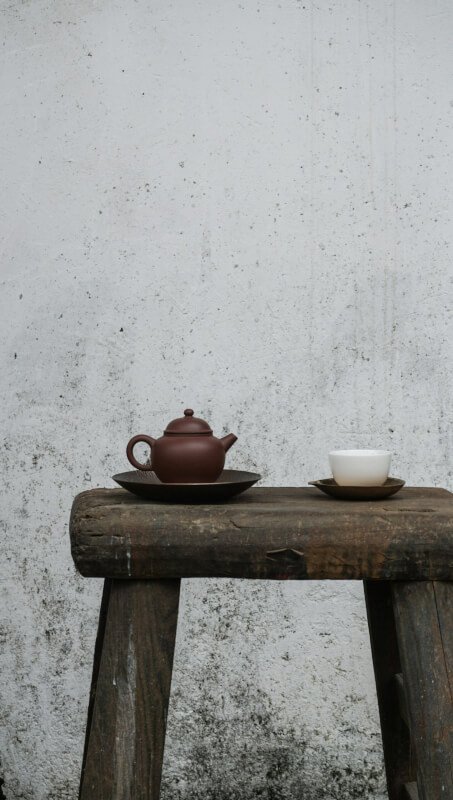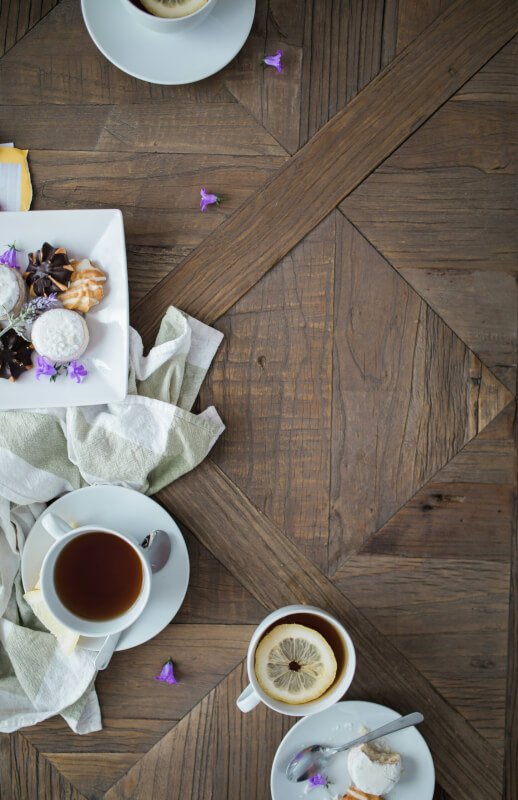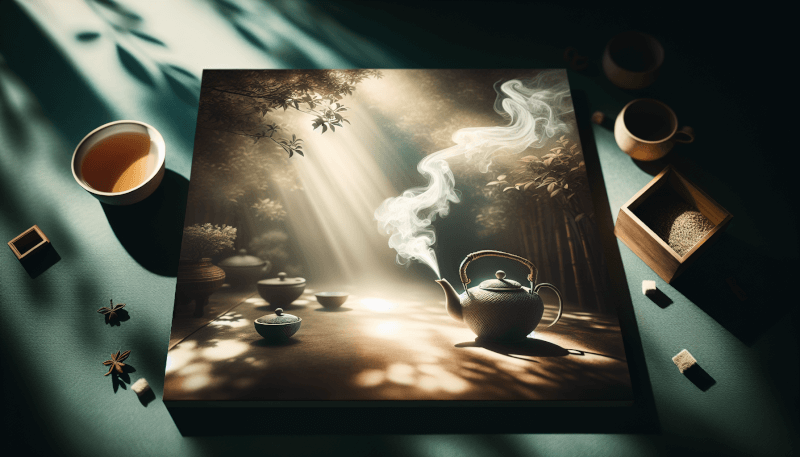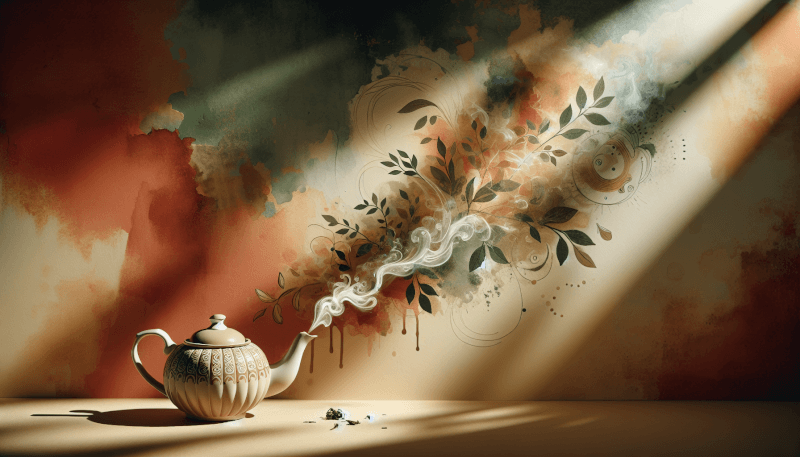Are you tired of the same old tea flavors and craving something unique and exciting? Look no further! In this article, you will discover the art and science behind creating the perfect tea blend using advanced brewing techniques. From selecting the finest tea leaves to experimenting with different herbs and spices, we will guide you on a journey towards crafting your own personalized tea blend that will tantalize your taste buds and leave you craving for more. Get ready to explore a world of flavors and elevate your tea-drinking experience to new heights!

Choosing the Right Tea Leaves
Tea is a versatile beverage enjoyed by many around the world. With its rich history and cultural significance, tea has become an integral part of our daily lives. When it comes to brewing the perfect cup of tea, choosing the right tea leaves is essential. There are various types of tea available, each with its own unique flavor and characteristics. Understanding the different types of tea will help you make an informed decision and select the best tea leaves for your desired taste.
Understanding the Different Types of Tea
Tea is categorized into different types based on the way it is processed. The main types of tea include black tea, green tea, oolong tea, white tea, and herbal tea. Black tea is fully oxidized, resulting in a bold and robust flavor. Green tea, on the other hand, is minimally processed and retains its natural flavor and antioxidants. Oolong tea falls between black and green tea in terms of oxidation, offering a wide range of flavors and complexities. White tea is the least processed and has a subtle and delicate flavor. Herbal tea, also known as tisanes, is made from herbs, fruits, and flowers, providing a wide variety of flavors and health benefits.
Exploring the Flavor Profiles
Each type of tea has its own unique flavor profile, making it suitable for different preferences and occasions. Black tea is known for its full-bodied and rich flavor, often accompanied by notes of malt, caramel, and even fruity undertones. Green tea is light and refreshing with a slightly grassy or vegetal taste, sometimes accompanied by floral or nutty notes. Oolong tea has a complex flavor profile, ranging from floral and fruity to toasty and earthy, depending on the oxidation level. White tea offers a delicate and subtle flavor, often described as floral or sweet. Herbal tea provides a wide range of flavors, from soothing chamomile to refreshing mint.
Selecting High-Quality Tea Leaves
When choosing tea leaves, it is important to prioritize quality. High-quality tea leaves will ensure a flavorful and enjoyable cup of tea. Look for tea leaves that are whole, unbroken, and free from dust or fannings. Whole leaves retain their essential oils and flavors, resulting in a more aromatic and flavorful brew. Additionally, consider purchasing tea from reputable sources that prioritize freshness and sustainability. This will ensure that you are getting the best quality tea leaves that have been handled and stored properly.
Understanding the Brewing Process
Brewing tea is both an art and a science. To achieve the perfect cup of tea, it is important to understand the brewing process and the factors that influence the flavors and aromas.
Essential Equipment and Tools
To brew tea properly, you will need some essential equipment and tools. A teapot or a tea infuser is necessary for steeping the tea leaves. Choose a teapot or infuser that is suitable for the type of tea you are brewing. For example, a teapot with a built-in strainer may be ideal for loose-leaf tea, while a small infuser ball may work well for individual cups of tea. Additionally, a thermometer can be useful for controlling water temperature, and a timer will help you keep track of steeping time.
Measuring Tea Leaves and Water Ratios
The proper measurement of tea leaves and water ratios is crucial for brewing a well-balanced cup of tea. The general guideline is to use approximately 2 grams of tea leaves for every 8 ounces of water. However, this can vary depending on personal preference and the type of tea. Experiment with different ratios to find the perfect balance that suits your taste.
Controlling Water Temperature
Water temperature plays a vital role in extracting the flavors and aromas from tea leaves. Different types of tea require different water temperatures. Generally, green and white teas are brewed at lower temperatures, ranging from 160°F to 180°F (71°C to 82°C), while black and oolong teas are brewed at higher temperatures, ranging from 190°F to 212°F (88°C to 100°C). Using water that is too hot can result in bitter or astringent flavors, while using water that is too cold may result in a weak and flavorless brew.
Steeping Time and Techniques
The duration of steeping time also contributes to the flavor and strength of the tea. Steeping times can vary depending on the type of tea and personal preference. It is generally recommended to steep black tea for 3-5 minutes, green tea for 2-3 minutes, oolong tea for 3-7 minutes, white tea for 2-4 minutes, and herbal tea for 5-7 minutes. Adjust the steeping time according to your taste and experiment to find the perfect balance of flavors.

Exploring Tea Blending Techniques
Tea blending is an art that allows you to create unique and personalized flavors. By combining different types of tea, herbs, spices, and flowers, you can create an endless variety of tea blends.
Understanding the Art of Tea Blending
Tea blending involves combining different teas and ingredients to create new and exciting flavor combinations. It requires a careful balance of flavors, aromas, and textures. The art of blending lies in understanding the characteristics of each component and how they interact with one another.
Combining Different Types of Tea
One of the key aspects of tea blending is the combination of different types of tea. By blending black tea with green tea or oolong tea, you can create a unique harmony of flavors. The boldness of black tea can be balanced by the refreshing and delicate characteristics of green tea, resulting in a well-rounded blend. Similarly, oolong teas can add depth and complexity to a blend, elevating the overall flavor profile.
Adding Herbs, Spices, and Flowers
To further enhance the flavor profile of a tea blend, herbs, spices, and flowers can be incorporated. By adding ingredients like mint, chamomile, cinnamon, or rose petals, you can create a tea blend that is not only flavorful but also visually appealing. Herbs and spices can provide additional health benefits and medicinal properties, making your tea blend both delicious and beneficial for your well-being.
Experimenting with Flavors and Aromas
Tea blending allows for endless experimentation with flavors and aromas. By combining different ingredients, you can create unique blends that cater to your personal preferences. Whether you prefer a floral and calming blend, a bold and invigorating blend, or a soothing and comforting blend, the possibilities are endless. Don’t be afraid to try new combinations and adjust the proportions to achieve the desired flavor.
Enhancing Tea Flavor with Temperature Control
Temperature control during tea brewing is a crucial factor that can greatly impact the flavor extraction and overall taste of the tea.
The Impact of Temperature on Tea Extraction
Water temperature plays a significant role in releasing the flavors and aroma compounds present in tea leaves. Higher temperatures result in a faster extraction process, while lower temperatures allow for a slower and more delicate release of flavors. It’s important to find the optimal temperature range for each type of tea to achieve the desired taste profile.
Optimal Temperatures for Different Types of Tea
Each type of tea has its own recommended temperature range for optimal flavor extraction. For example, green tea is usually brewed at temperatures between 160°F to 180°F (71°C to 82°C) to avoid a bitter taste. Black tea, known for its bold and robust flavors, can withstand higher temperatures ranging from 190°F to 212°F (88°C to 100°C). Oolong tea falls somewhere in between, typically brewed at temperatures around 180°F to 200°F (82°C to 93°C). By adjusting the water temperature according to the type of tea, you can unlock the full range of flavors.
Using Specialty Temperature-Controlled Equipment
For tea enthusiasts who want precise control over water temperature, specialty temperature-controlled equipment can be a valuable tool. Electric kettles or tea makers with temperature settings allow you to select the desired temperature for different types of tea. This ensures accuracy and consistency in brewing, resulting in a more enjoyable tea experience. Investing in such equipment can be beneficial if you are a tea lover who values precision and wants to elevate your brewing techniques.

The Power of Time in Tea Brewing
Time plays a crucial role in tea brewing, influencing the strength, flavor, and overall quality of the final cup of tea. Understanding the effects of steeping time and exploring different brewing techniques can help you achieve the perfect cup.
Exploring the Effects of Steeping Time
The duration of steeping time can greatly impact the flavor and character of the tea. Steeping for longer periods enhances the extraction of flavors, resulting in a stronger brew. However, longer steeping times can also lead to increased bitterness or astringency. Conversely, shorter steeping times produce a milder cup with lighter flavors. Experimenting with different steeping times allows you to find your preferred strength and balance.
Adjusting Steeping Time for Different Blends
The optimal steeping time can vary depending on the type of tea and the blend of ingredients used. Herbal teas, for example, often require longer steeping times to extract their full flavors and benefits. Black teas, on the other hand, may become bitter if steeped for too long. Adjusting the steeping time based on the specific blend will help you achieve the desired taste profile and ensure the best possible cup of tea.
Utilizing Cold Brew and Flash Infusion Techniques
In addition to traditional hot brewing methods, cold brew and flash infusion techniques offer alternative ways to extract flavors from tea leaves. Cold brew involves steeping tea leaves in cold or room temperature water for an extended period, usually several hours. This method results in a smoother and less bitter brew with a different flavor profile. Flash infusion, on the other hand, involves quickly steeping tea leaves in hot water for a short period, usually just a few seconds. This technique is often used for high-quality green teas to highlight their delicate flavors. Experimenting with these alternative brewing methods can offer exciting new tastes and textures.
Utilizing Water Quality and Filtering
Water quality plays a significant role in the overall taste and flavor of tea. Understanding the role of water in tea brewing and considering factors such as water sources and mineral content can help enhance your tea experience.
Understanding the Role of Water in Tea Brewing
Water acts as a medium for extracting flavors from tea leaves, so its quality greatly impacts the taste of the brewed tea. The mineral content, pH level, and overall purity of the water can affect the extraction process and interactions with tea compounds. High mineral content can result in a more robust and pronounced flavor, while softer water can bring out delicate nuances. Selecting the right water for brewing is essential for achieving the desired taste profile.
Considering Water Sources and Mineral Content
Different water sources can vary in mineral content and overall characteristics. Tap water, for example, often contains varying levels of minerals and chemicals, which can influence the taste of the tea. Filtered water or spring water can provide a cleaner and purer base for brewing tea, allowing the flavors of the tea leaves to shine through. Experimenting with different water sources can help you discover which one complements your preferred type of tea.
Using Filtration Systems to Enhance Flavor
If your tap water has a strong taste or high mineral content, utilizing a filtration system can help enhance the flavor of your tea. Water filters remove impurities, such as chlorine and heavy metals, providing a cleaner and more neutral tasting water. This allows the true flavors and characteristics of the tea to come forward without any unwanted interference. Investing in a quality water filtration system can significantly improve your tea brewing experience.

Experimenting with Tea Ratios and Proportions
The balance between tea leaves and water ratios can greatly impact the strength and flavor of the brewed tea. By understanding the nuances of different ratios and exploring various brewing vessels, you can create unique and enjoyable tea experiences.
Finding the Perfect Balance of Tea Leaves
The ratio of tea leaves to water is a crucial factor in determining the strength and flavor intensity of the brewed tea. While individual preferences may vary, a general guideline is to use approximately 2 grams of tea leaves for every 8 ounces of water. However, feel free to experiment and adjust the proportions according to your personal taste. Increasing the amount of tea leaves will result in a stronger brew, while reducing the amount will produce a milder cup.
Understanding Strength and Weakness of Different Ratios
Different ratios of tea leaves to water can bring out different characteristics of the tea. Using a higher ratio will extract more flavors, resulting in a stronger and potentially more robust cup. Conversely, using a lower ratio will result in a milder brew with delicate flavors. Depending on the type of tea and your desired taste, you can experiment with different ratios to achieve the perfect balance of flavors.
Exploring Different Brewing Vessels for Unique Ratios
The choice of brewing vessel can also influence the tea leaf to water ratio and subsequently the flavor profile of the brewed tea. Different vessels have varying capacities and allow for different levels of water and tea leaf interaction. For example, a smaller teapot or even an individual cup allows for more concentrated flavors due to a higher ratio of tea leaves to water. Larger teapots, on the other hand, may yield a milder brew due to a lower ratio. Experimenting with different brewing vessels can lead to exciting discoveries and enhance your tea brewing journey.
Incorporating Tea Accessories for Flavor Enhancement
Tea accessories can enhance your tea brewing experience by providing convenience, efficiency, and even subtle flavor enhancements. From infusers and strainers to specialized tea cups and mugs, these accessories can elevate your tea drinking ritual.
Infusers, Tea Balls, and Tea Bags
Infusers, tea balls, and tea bags are popular accessories that allow for easy steeping and strain-free brewing. Infusers come in various shapes and sizes, allowing the tea leaves to expand and release their flavors while keeping them contained. Tea bags offer a convenient way to brew tea on the go, allowing for easy disposal after use. Tea balls provide a more traditional approach, allowing for loose-leaf tea to steep in a contained space.
Tea Strainers and Filters
Tea strainers and filters are useful tools for removing any loose tea leaves or particles from the brewed tea. They ensure a smooth and enjoyable tea-drinking experience by preventing unwanted debris from entering your cup. Strainers can be easily placed over a teapot or individual cup, allowing the tea to flow through while trapping the leaves or particles.
Savoring the Flavor with Tea Cups and Mugs
The choice of tea cups and mugs can also enhance the flavor and visual experience of drinking tea. Porcelain or ceramic cups are often preferred for their ability to retain heat and showcase the color of the brewed tea. Glass cups allow for a visual appreciation of the tea leaves as they steep and add a unique aesthetic element. Choosing the right cup or mug that fits your personal style and preference can make every sip of tea more enjoyable.

Unleashing Flavors with Pre-Brewing Techniques
Pre-brewing techniques can enhance the overall tea brewing experience by preparing the tea leaves, teapot, and cups for optimal flavor extraction and enjoyment.
Rainwater Rinsing and Soaking
Rinsing or soaking tea leaves with rainwater before brewing can help remove any dust or impurities, resulting in a cleaner and purer infusion. Rainwater is often favored due to its softness and lack of minerals or chemicals. Simply rinsing the tea leaves with rainwater for a few seconds before brewing can elevate the overall tea-drinking experience.
Warming the Teapot
Warming the teapot before brewing can help maintain the temperature of the water and ensure even heat distribution, resulting in a more consistent and enjoyable brew. It also adds a layer of warmth to the tea leaves, allowing them to unfold and release their flavors more effectively. To warm the teapot, simply pour hot water into the empty teapot and discard it before adding the tea leaves and fresh hot water for brewing.
Pre-Heating the Cups
Similar to warming the teapot, pre-heating the cups can help maintain the temperature of the brewed tea and ensure optimal flavor extraction. Adding hot water to each cup and discarding it before pouring the brewed tea will prevent the tea from cooling down too quickly, allowing you to savor the flavors at their best. Pre-heated cups also provide a sensory pleasure as you hold and drink from a warm vessel.
Mastering Tea Brewing and Tasting
Mastering the art of tea brewing and tasting is a journey that involves developing a palate for tea, identifying flavor profiles and notes, and evaluating the aroma, color, and taste of the brewed tea.
Developing a Palate for Tea
Developing a palate for tea takes time and practice. By regularly tasting different types of tea, you can train your taste buds to identify the subtle nuances and flavors present in each cup. Pay attention to the texture, mouthfeel, and aftertaste of the tea. The more you experience and experiment, the more refined your palate will become.
Identifying Flavor Profiles and Notes
Tea, like wine, has a complex range of flavors and aromas that can be identified and appreciated. As you taste different teas, try to identify the dominant flavor profiles and any underlying notes. Is it floral, fruity, or earthy? Are there hints of citrus, chocolate, or spices? Keeping a tasting journal can be a helpful tool for recording your observations and tracking your journey of discovering different flavor profiles.
Evaluating the Aroma, Color, and Taste
When evaluating a cup of tea, take note of the aroma, color, and taste. The aroma can provide insight into the flavors to expect. The color of the brewed tea can vary depending on the type and processing method, ranging from pale yellow to deep amber or even vibrant green. Finally, evaluate the taste by assessing the balance of flavors, the level of bitterness or astringency, and the overall enjoyment of the tea. Engaging all your senses while sipping tea will enhance your appreciation for this ancient beverage.
In conclusion, brewing the perfect cup of tea requires an understanding of the different types of tea, the brewing process, and various techniques to enhance flavor. By choosing high-quality tea leaves, controlling water temperature, adjusting steeping time, and experimenting with different ingredients and ratios, you can create a tea experience that is tailored to your taste and preferences. Remember to explore and enjoy the vast world of tea, and let your senses guide you on this delightful journey. Cheers to the art of tea brewing!


